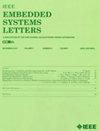敲门:通过对 NoC 的定时攻击逆向工程 MPSoC 布局
IF 1.7
4区 计算机科学
Q3 COMPUTER SCIENCE, HARDWARE & ARCHITECTURE
引用次数: 0
摘要
多处理器片上系统(MPSoC)已经成为一种高度通用和高效的平台,适用于广泛的应用,如多媒体应用和电信架构。MPSoC的关键组件之一是片上网络(NoC),它促进了各种处理元件(pe)的互连,从而实现高效的数据通信。在NoC上已经提出了几种定时攻击,例如Earthquake攻击、P+P爆竹和P+P箭头,它们利用操作执行时间的变化来推断加密密钥。在这封信中,我们建议利用NoC的定时攻击来逆向工程每个PE到MPSoC架构的映射。据我们所知,第一项工作依赖于在发送到不同pe的请求之间创建争用,并仅通过分析应答延迟来揭示布局。在实验设置中,我们能够以100%的精度映射由Mesh, Torus, Point-to-Point, Ring和flat Butterfly NoC拓扑组成的MPSoC的pe,这对攻击者在侦察阶段非常有用。此外,由于对抗定时攻击的现有缓解技术是基于在安全-不安全域的数据包之间创建争用的假设,因此它们将无法缓解所提议的反向工程攻击。本文章由计算机程序翻译,如有差异,请以英文原文为准。
Door Knock: Reverse Engineering the MPSoC Layout Through Timing Attack on NoC
Multiprocessor systems-on-chip (MPSoC) have emerged as highly versatile and efficient platforms suitable for a wide range of applications like multimedia applications and telecommunication architectures. One of the key components in MPSoC is the network-on-chip (NoC), which facilitates the interconnection of various processing elements (PEs), enabling efficient data communication. Several timing attacks, such as Earthquake attack, P+P Firecracker, and P+P Arrow, have been proposed on NoC that exploit the variations in execution times of operations to infer cryptographic keys. In this letter, we propose to leverage the timing attack on NoC to reverse engineer the mapping of each PE onto the MPSoC architecture. To the best of our knowledge, it is the first work that relies on creating the contention between the requests that are sent to different PEs and reveal the layout by just analyzing the reply latency. In the experimental setup, we are able to map PEs for MPSoC consists of Mesh, Torus, Point-to-Point, Ring, and Flattened Butterfly NoC topology with 100% accuracy that can be extremely useful for the attackers in the reconnaissance phase. Further, as the existing mitigation techniques to counter timing attacks are based on the assumption that the contention is created between the packets of secure-insecure domains, they will not be able to mitigate the proposed reverse engineering attack.
求助全文
通过发布文献求助,成功后即可免费获取论文全文。
去求助
来源期刊

IEEE Embedded Systems Letters
Engineering-Control and Systems Engineering
CiteScore
3.30
自引率
0.00%
发文量
65
期刊介绍:
The IEEE Embedded Systems Letters (ESL), provides a forum for rapid dissemination of latest technical advances in embedded systems and related areas in embedded software. The emphasis is on models, methods, and tools that ensure secure, correct, efficient and robust design of embedded systems and their applications.
 求助内容:
求助内容: 应助结果提醒方式:
应助结果提醒方式:


